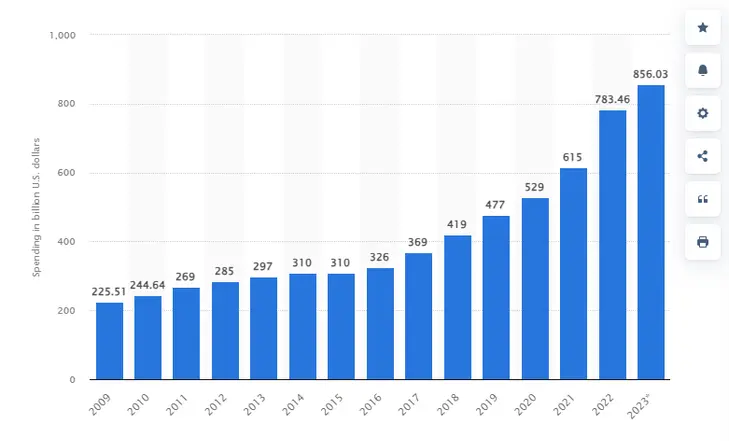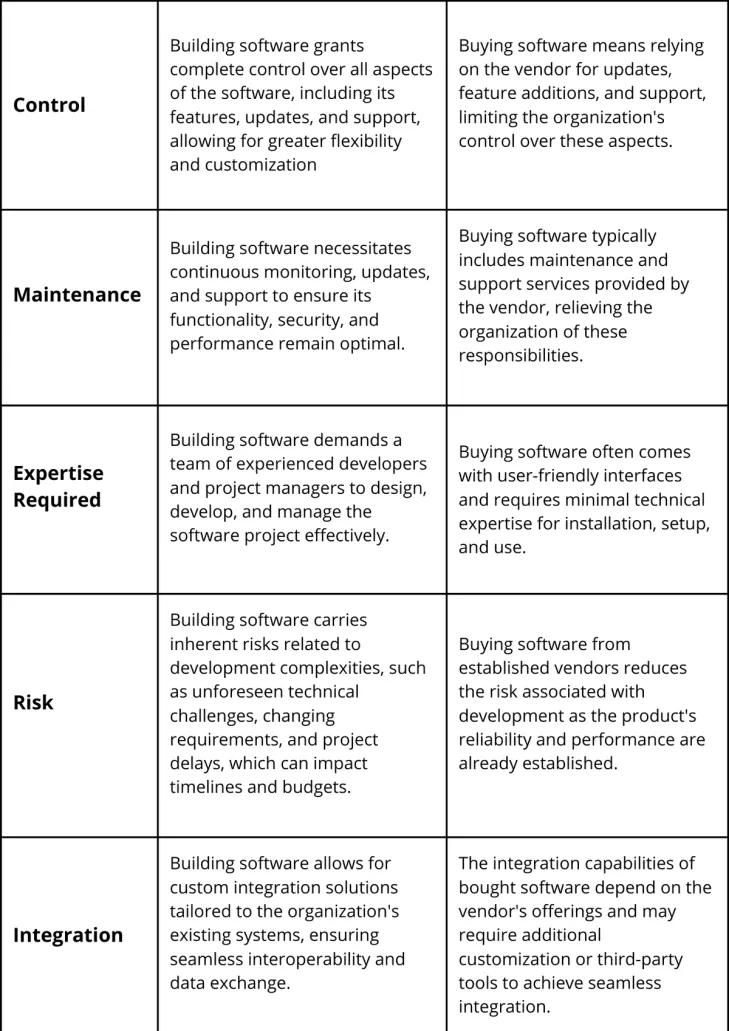In today's fast-paced and technology-driven world, businesses are constantly faced with the decision of whether to build or buy software to meet their specific needs. But how do you make the right choice? Whether you're a startup or an established company, weighing the options of building or buying software is crucial. Both paths have their pros and cons, and finding the best fit for your business requires careful consideration. Building software from scratch gives you complete control over customization and functionality, allowing you to create a solution tailored to your unique requirements.
On the other hand, buying software offers the advantage of saving time and resources, as you can leverage pre-built solutions that have been tried and tested. To make an informed decision, factors such as budget, timeline, scalability, and long-term maintenance need to be taken into account. Additionally, it's important to consider the expertise and resources available within your organization. In this article, we will explore the benefits and drawbacks of both options, as well as provide valuable insights to help you make the choice that suits your business best.
According to Forbes, many people think buying software is cheaper than making it. But the real cost of owning software depends on lots of things. In this blog, we'll help you choose the best option for your needs by clearing up common confusion among professionals in the software development field.
We'll delve into the definitions and considerations before opting for building or buying software, highlight the key differences, outline the pros and cons of each approach, and ultimately help you determine which option is better for your needs.
Building a Software
A study conducted by Statista states that global software investments hit $672 billion in 2022 and are projected to reach or surpass $750 billion in 2023. In general, it's quite interesting to observe that companies are increasingly investing in software.
Building software involves creating a solution from scratch by focusing on specific needs and requirements. This approach offers maximum flexibility and control over features, website or mobile ux design principles, and functionality. However, it demands significant time, resources, and expertise, particularly during the development, testing, and maintenance phases.
Considerations Before Building Software
Let us explore the following points to know key considerations before building software:
Figure out what you need:
Engage with stakeholders to comprehensively understand software requirements, objectives, and underlying needs. Documenting requirements ensures alignment and clarity throughout the development process.
Check your Resources:
Assess financial, human, and time-related factors to ensure adequate budget, team skills, and project timeline alignment with organizational goals and deadlines.
Plan Your Budget and Time:
Decide how much money you can spend and how long it will take to finish or use the third choice, i.e., low-code application development. Gartner predicts that by 2025, 70% of new applications developed by enterprises will use low- or no-code technologies.
Choose the Right Tools:
Select suitable programming languages and tools based on project requirements, team expertise, and scalability. Consider factors like performance, compatibility, community support, and long-term maintenance.
Make Sure It Can Grow:
Architect the software with scalability in mind, using modular design and scalable infrastructure to accommodate future user growth and feature enhancements. Regularly review and update scalability strategies.
Test it Well:
Implement comprehensive testing procedures, including unit tests, integration tests, and user acceptance testing, to ensure the software functions correctly, meets requirements, and delivers a seamless user experience. Address any identified issues promptly.
Keep It Safe:
Employ the best security measures, including data encryption, access controls, and regular security audits, to safeguard against potential threats and ensure compliance with relevant regulations and standards.
Write Down How It Works:
Develop user manuals, documentation, and troubleshooting guides to assist users in understanding and effectively utilizing the software. Provide clear instructions for installation, configuration, and troubleshooting to enhance user experience and support.
Satisfaction:
A study suggests that satisfaction levels are higher when you develop your software internally. Outsourced development, on the other hand, tends to yield lower satisfaction levels, with just 17.8% of companies expressing complete satisfaction with the work provided.
If you are looking for a consulting and product development agency, SoluteLabs offers web development, mobile development, UI/UX design, cloud services, and consulting services. Get in touch with us today for your custom software development requirements.
Pros of Building Software
Scalability:
When software is designed with scalability in mind, it can seamlessly accommodate increased user loads or expanded functionalities as a business grows. For example, cloud-based platforms like Amazon Web Services (AWS) provide scalable infrastructure, allowing applications to handle varying levels of traffic without major overhauls.
Competitive Advantage:
Unique features and capabilities embedded within software can differentiate it from competitors, attracting customers and enhancing market positioning. According to Recostream, In the year 2020 alone, Netflix gained over 37 million new subscribers, of which as much as 80% came from outside the United States this happened due to Netflix's recommendation algorithm which provides a competitive edge by offering personalized content suggestions, helping users to stay engaged.
Full Control:
Internal development grants complete autonomy over updates, maintenance, and support, ensuring timely responses to user needs and market changes. As, Google's in-house development of Android OS enables precise control over updates and feature rollouts, optimizing user experience and addressing vulnerabilities swiftly.
Ownership:
Holding intellectual property rights to software safeguards proprietary innovations and grants exclusive control over its distribution and modification. For example, Microsoft owns the rights to its Windows operating system, enabling strategic licensing agreements and preventing unauthorized replication, thus preserving its market dominance.
Cons of Building Software
Risk of Failure:
Software projects are prone to various risks, including delays, budget overruns, and failure to meet user expectations. For example, According to The New York Times, Despite substantial investment, Uber's self-driving vehicle initiative encountered technical challenges and safety apprehensions, resulting in setbacks.
High Custom Development Cost:
Developing software for specific needs often involves significant expenses, including hiring skilled developers and project managers. An example is a large e-commerce platform that requires extensive customization to integrate with existing systems, resulting in substantial development costs.
Time-Consuming:
Developing software from scratch demands considerable time investment, potentially delaying its launch to market. Building a social media platform like Facebook, with its ever-evolving features, takes constant development and iteration, delaying the launch of new functionalities.
Technical Complexity:
Building software requires expertise in various areas, like programming languages, frameworks, and databases. Creating a game like Grand Theft Auto requires expertise in graphics rendering, physics simulation, and AI, which can be challenging for smaller teams.
Buying a Software
On the other hand, opting to Buy software or utilizing third-party solutions can speed up the development process and reduce initial costs. This approach often involves licensing or subscribing to software services or platforms that already offer the desired features and functionalities. It can be particularly advantageous for businesses looking for rapid deployment or lacking in-house development capabilities. However, there may also be compromises in terms of customization, scalability, and long-term adaptability to evolving needs.
Considerations Before Buying Software:
Now we will look at the following points to understand the important things to think about before buying software:
Know What You Need:
Evaluate your software requirements thoroughly and explore existing solutions to determine if there's a suitable fit. Consider functionality, scalability, and customization options to meet your specific needs effectively.
Check out the Seller:
Research the software vendor's reputation, reliability, and customer reviews. Evaluate their track record, support services, and responsiveness to ensure a positive working relationship and reliable support throughout.
Make Sure It Can Change:
Assess the software's flexibility and customization capabilities to ensure it can adapt to evolving needs and integrate seamlessly with your existing systems. Verify options for updates, upgrades, and customization to accommodate future changes effectively.
Think About All the Costs:
As per Gartner's research, when seeking software, 49% of buyers prioritize price as the most significant factor. Consider the expenses associated with purchasing, implementing, and maintaining the software to explore ways to minimize software development costs.
See If It Can Grow With You:
Assess the software's scalability and upgradability to accommodate future growth and evolving needs. Ensure it offers features like modular design, flexible architecture, and seamless update processes.
Get Help When You Need It:
Verify the availability and responsiveness of the software vendor's support services. Ensure they offer timely assistance, troubleshooting, and resolution of issues to minimize downtime and ensure smooth operations.
Keep It Safe:
According to Gartner, an additional factor that 48% of buyers prioritize is security. Ensure that the software is secure to use and effectively protects your information.
Teach People How to Use It:
Develop comprehensive training materials, including user manuals, tutorials, and workshops, to educate users on software functionality and best practices. Provide ongoing support and resources to facilitate effective utilization and productivity.
Pros of Buying Software
Quick Deployment:
Software can be deployed quickly after purchase, allowing for immediate use, as building a custom solution can take up to six to nine months, as per the study conducted by Forbes.
Vendor Support:
Opting for software from vendors entails access to maintenance, updates, and support services, alleviating the workload on your team. For instance, a company adopting a customer relationship management (CRM) system benefits from vendor-provided support for resolving technical issues and implementing software updates, enabling the in-house team to focus on core business tasks rather than software maintenance.
Reduced Risk:
Established products have a track record of reliability and may come with warranties or service-level agreements. For example, Established software like Microsoft Office is battle-tested and comes with warranties against defects, minimizing the risk of unexpected issues. This reduces the potential financial and operational disruptions from software malfunctions
Minimal Technical Expertise Required:
Typically, it requires minimal technical expertise for setup and use. Tools like Zoom, with its intuitive interface and detailed user guides, require minimal technical expertise to set up and utilize, even for non-technical users.
Cons of Buying Software
Limited Customization:
Off-the-shelf software solutions may not fully align with unique business needs, offering limited customization options. As per The New York Times, a company named Peloton, a fitness equipment company, faced issues with their Tread+ treadmill due to software limitations. This resulted in several accidents where users were thrown off the treadmill due to unexpected speed increases.
Dependency on Vendor:
Relying on a vendor for updates, features, and support means relinquishing control, possibly resulting in delays or issues. For example, a company using cloud-based email services may experience disruptions or feature limitations due to vendor-mandated updates or maintenance, impacting communication and productivity.
Integration Challenges:
Integrating software with existing systems can be complex, especially if compatibility issues arise. A manufacturing firm implementing an enterprise resource planning (ERP) system may encounter difficulties integrating it with legacy manufacturing software, requiring extensive customization or middleware solutions to ensure seamless data exchange and operational continuity.
Potential Hidden Costs:
Adopting off-the-shelf software may incur unforeseen expenses such as licensing fees, implementation costs, training, and customization. An example is Dollar Shave Club (DSC) that is a Software: Enterprise Resource Planning (ERP) System that initially anticipated a smooth implementation of their chosen ERP system, then they faced unforeseen complexities and delays, leading to significant cost overruns.
Differences Between Build vs. Buy Software
In this section, we will have a detailed comparison of building software versus buying software presented in tabular form:
Also, Read: What is Technical Debt in Software Development—How to Identify andManage It?
Build vs. Buy Software: Which One is Best for You?
Deciding whether to build or buy software depends on what's best for your organization. Below are the various circumstances under which you can decide between the two:
Budget Constraints
- Buy Software: If you have limited financial resources or need a solution quickly, purchasing existing software can be more cost-effective and time-efficient.
- Build Software: If you have a sufficient budget and require specific features best suited to your unique requirements, building custom software may be worth the investment in the long run.
Time Sensitivity
- Buy Software: When time is of the essence and you need a solution immediately, buying pre-built software can provide a faster implementation time.
- Build Software: If you have the luxury of time and need a highly customized solution that aligns perfectly with your business processes, building software in-house allows for meticulous planning and development.
Complexity of Requirements
- Buy Software: For standard or common business needs where customization isn't crucial, off-the-shelf software can often meet your requirements adequately.
- Build Software: If your requirements are highly complex or unique to your organization's operations, building bespoke software offers flexibility to every aspect of your exact specifications.
Long-Term Scalability
- Buy Software: If scalability is a top priority and you anticipate rapid growth, choosing software that can easily scale with your business needs is essential.
- Build Software: When you need complete control over scalability and want a solution that can adapt easily to evolving demands without limitations imposed by third-party vendors, building custom software provides the flexibility to scale as needed.
Integration Requirements
- Buy Software: If your software needs to integrate with other existing systems or platforms, selecting pre-built software with extensive integration capabilities can simplify the process.
- Build Software: When you require deep integration with proprietary systems or third-party APIs that are not supported by off-the-shelf solutions, building custom software allows for seamless integration based on your specific ecosystem.
Ultimately, the decision between building and buying software depends on your organization's unique needs, resources, and strategic objectives. Evaluating these factors carefully will help you determine the best approach for your software solution.
How did other companies make the Build vs. Buy Decision?
In this section, we'll delve into two well-known examples that have navigated the decision between building and buying software solutions.
Slack
One notable example of a company facing the build vs. buy decision is Slack Technologies, Inc. When Slack was first created, the company had to decide whether to develop its own messaging platform from scratch or to purchase an existing solution. Instead of building their own messaging system,
Slack's founders decided to acquire an existing product called "Glitch." They then modified and rebranded it as Slack, which eventually became one of the most popular workplace communication tools globally. This decision allowed Slack to enter the market quickly and focus on refining the product rather than spending time and resources on building a messaging platform from the ground up.
Facebook initially faced the decision of whether to build a photo-sharing platform from scratch or to acquire an existing one. Despite having the resources and talent to develop their own photo-sharing app, Facebook ultimately chose to acquire Instagram for approximately $1 billion.
Building a new platform from scratch would have taken a significant amount of time to develop, test, and launch. By acquiring Instagram, Facebook gained immediate access to a popular and well-established photo-sharing app with millions of users.
The above two examples represent real-life scenarios where organizations faced the dilemma of whether to buy or build software. By understanding their needs and following their strategies, they successfully resolved these uncertainties, leading to optimal outcomes.
Summing Up
Considering these trends and factors, it's important for organizations to be flexible and strategic when getting software. They should think carefully about whether to build or buy software, depending on what's best for them in each situation. By keeping up with new technologies and what's happening in the market, organizations can make smart choices that match their goals and help them do well in the fast-changing digital world.
Frequently Asked Questions
Have a product idea?
Talk to our experts to see how you can turn it
into an engaging, sustainable digital product.







